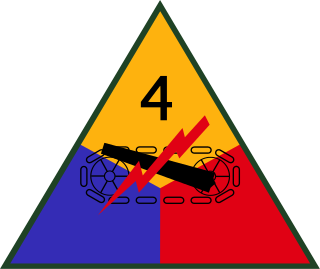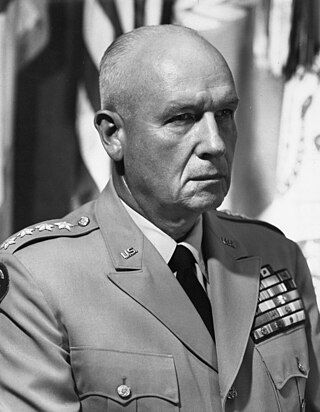
The European Theater of Operations, United States Army (ETOUSA) was a theater of Operations responsible for directing United States Army operations throughout the European theatre of World War II, from 1942 to 1945. It commanded Army Ground Forces (AGF), United States Army Air Forces (USAAF), and Army Service Forces (ASF) operations north of Italy and the Mediterranean coast. It was bordered to the south by the North African Theater of Operations, United States Army (NATOUSA), which later became the Mediterranean Theater of Operations, United States Army (MTOUSA).

The 4th Armored Division was an armored division of the United States Army that earned distinction while spearheading General Patton's Third Army in the European theater of World War II.

The 12th Armored Division was an armored division of the United States Army in World War II. It fought in the European Theater of Operations in France, Germany and Austria, between November 1944 and May 1945.

The 89th Infantry Division, originally known as the "89th Division," was an infantry formation of the United States Army that was active during World War I, World War II, and the Cold War.

The 80th Training Command is a formation of the United States Army Reserve.

The 83rd Infantry Division ("Thunderbolt") was a formation of the United States Army in World War I and World War II.

The 86th Infantry Division, also known as the Blackhawk Division, was a unit of the United States Army in World War I and World War II. Currently called the 86th Training Division, based at Fort McCoy, Wisconsin, members of the division now work with Active Army, Reserve, and National Guard units to provide them with a Decisive Action Training Environment on a yearly basis.
The Mediterranean Theater of Operations, United States Army (MTOUSA), originally called the North African Theater of Operations, United States Army (NATOUSA), was a military formation of the United States Army that supervised all U.S. Army forces which fought in North Africa and Italy during World War II.

General Joseph Lawton Collins was a senior United States Army officer. During World War II, he served in both the Pacific and European Theaters of Operations, one of a few senior American commanders to do so. He was Chief of Staff of the United States Army during the Korean War.

The Transportation Corps is a combat service support branch of the U.S. Army. It is responsible for the movement of personnel and material by truck, rail, air, and sea. It is one of three U.S. Army logistics branches, the others being the Quartermaster Corps and the Ordnance Corps. The Corps was established in its current form on 31 July 1942, with predecessor services dating back to the American Civil War. The Transportation Corps is currently headquartered at Fort Gregg-Adams, Virginia. The officer in charge of the branch for doctrine, training, and professional development purposes is the Chief of Transportation (CoT) and Commandant of the US Army Transportation School, currently held by BG Beth A. Behn. The Corps's motto is "Nothing Happens Until Something Moves".

John Clifford Hodges Lee was a career US Army engineer, who rose to the rank of lieutenant general and commanded the Communications Zone (ComZ) in the European Theater of Operations during World War II.

The Services of Supply or "SOS" branch of the Army of the USA was created on 28 February 1942 by Executive Order Number 9082 "Reorganizing the Army and the War Department" and War Department Circular No. 59, dated 2 March 1942. Services of Supply became one of the three autonomous components of the Army of the United States on 9 March 1942. It was renamed the Army Service Forces on 12 March 1943, as it was felt that the term "supply" did not accurately describe its broad range of activities. From the day of inception in 1942 through the end of WWII, the SOS/ASF was commanded by Lieutenant General Brehon B. Somervell.

The Army Service Forces was one of the three autonomous components of the United States Army during World War II, the others being the Army Air Forces and Army Ground Forces, created on 9 March 1942. By dividing the Army into three large commands, the Chief of Staff, General George C. Marshall, drastically reduced the number of officers and agencies reporting directly to him. The Army Service Forces brought together elements of five different components of the Army: elements of the War Department General Staff (WDGS), especially its G-4 division ; the Office of the Under Secretary of War; the eight administrative bureaus; the nine corps areas, which became service commands; and the six supply arms and services, which became known as the technical services. The Army Service Forces was initially known as the United States Army Services of Supply but the name was changed on 12 March 1943, as it was felt that the term "supply" did not accurately describe the broad range of its activities. The Army Service Forces was abolished on 11 June 1946 and most of its functions were taken over by the War Department General Staff.

Carter Bowie Magruder was a United States Army general who served concurrently as Commander in Chief, United Nations Command/Commander, United States Forces Korea/Commanding General, Eighth United States Army from 1959 to 1961.

Lieutenant General Henry Spiese Aurand was a United States Army career officer. He was a veteran of World War I, World War II, and the Korean War. A graduate of the United States Military Academy at West Point, New York, Aurand was ranked 20th in the class of 1915, known as "the class the stars fell on" because no fewer than 59 of the 164 members of the class who graduated became generals. His classmates included Dwight D. Eisenhower and Omar Bradley, both of whom later achieved five-star rank. He was commissioned in the Coast Artillery Corps, but later transferred to the Ordnance Department.

Robert McGowan Littlejohn was a major general in the United States Army who graduated from the United States Military Academy at West Point, New York, in 1912. He served with the Pancho Villa Expedition and on the Western Front during the First World War, and was Chief Quartermaster for the European Theater of Operations during the Second World War. For this service, he received the Distinguished Service Medal. Upon retirement from the Army in 1946, then President of the United States Harry S. Truman appointed him head of the War Assets Administration.

An Armored group was a command and control headquarters in the United States Army equivalent to the headquarters of an armored division combat command during World War II. Most armored groups served in the European Theater of Operations (ETO). Typically an armored group was attached to each American corps in the European Theater of Operations.

Major General Albert Eger Brown was a decorated officer in the United States Army. A graduate of West Point, he was a veteran of Pancho Villa Expedition and both World Wars and is most noted for his service as commanding general (CG) of the 7th Infantry Division during the Aleutian Islands campaign of World War II.

American logistics played a key role in the success of Operation Overlord, the Allied invasion of northwest Europe during World War II. The campaign officially commenced on D-Day, 6 June 1944, and ended on 24 July, the day before the launch of Operation Cobra. The Services of Supply (SOS) was formed under the command of Major General John C. H. Lee in May 1942 to provide logistical support to the European Theater of Operations, United States Army. From February 1944 on, the SOS was increasingly referred to as the Communications Zone (COMZ). Between May 1942 and May 1944, Operation Bolero, the buildup of American troops and supplies in the UK, proceeded fitfully and by June 1944 1,526,965 US troops were in the UK, of whom 459,511 were part of the COMZ.

Royal Bertrand Lord was a United States Army general who served in World War II.



















